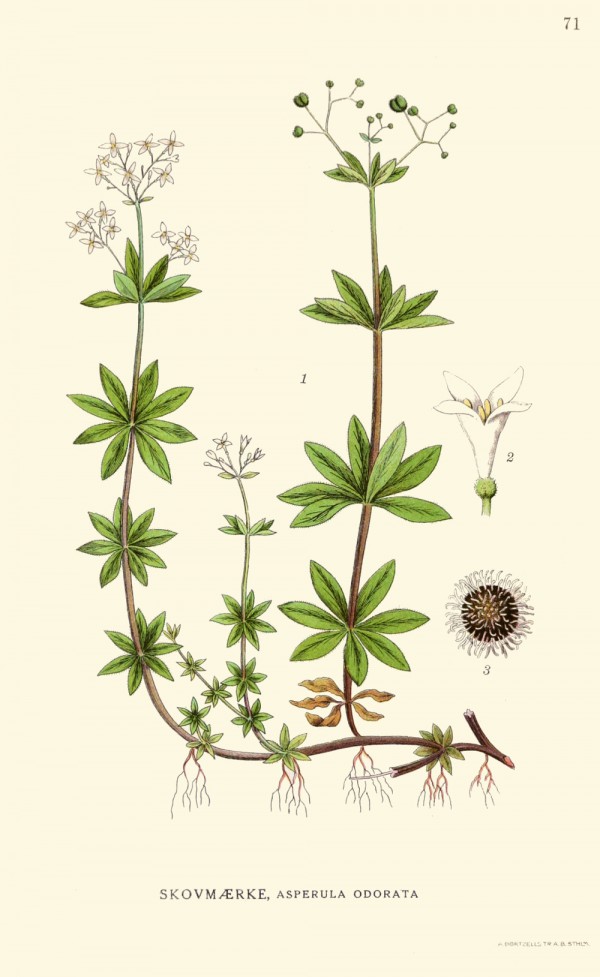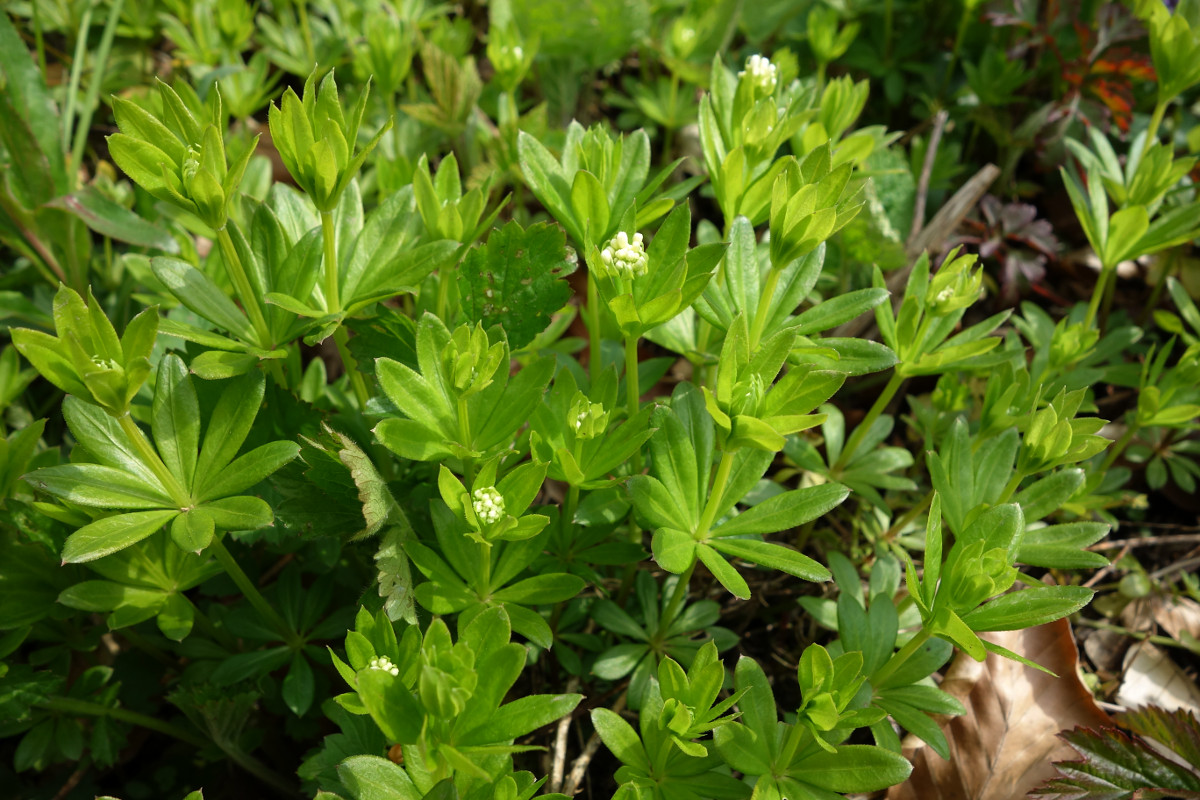Galium odoratum (L.) Scop. - syn. Asperula odorata L. - Rubiaceae - woodruff, sweetscented woodruff, sweet bedstraw, Waldmeister, Wohlriechendes Labkraut
Evergreen herb (5-50cm high) of Europe and West Asia; leaves borne in whorls of 6-9, simple, lanceolate; flowers white; foliage with a sweet scent of coumarin on wilting and drying.
„As the epithet odoratum suggests, the plant is strongly scented [Fresh plants are odorless! AK], the sweet scent being derived from coumarin. This scent increases on wilting and then persists on drying, and the dried plant is used in pot-pourri and as a moth deterrent. It is also used, mainly in Germany, to flavour May wine (called “Maibowle„ or „Maitrank“ in German), sweet juice punch, syrup for beer (Berliner Weisse), brandy, jelly, jam, a soft drink (Tarhun, which is Georgian), ice cream, and herbal tea.“ wikipedia
A vacuum headspace concentrate of freshly cut flowering woodfruff with excellent sensory properties contained more than 80% of coumarin (formed by cleavage of 2-hydroxycinnamic acid glucoside = o-coumaric acid glucoside) as artifact. Other constituents of this concentrate included linalool, borneol, caryophyllene, (Z)-3-hexenol and (Z)-3-hexenyl acetate.
[Surburg et al., Volatile compounds from Flowers, in: Teranishi, R.;Buttery, R. G.;Sugisawa, H. Bioactive volatile compounds from plants. (Book) 1993, 176]
The dried herb may contain up to 1% of coumarin (highest content in spring, April-May), which is produced spontaneously from o-coumaric acid glucoside on wilting (or from the fresh herb on enzymatic claevage in ethanolic solution in May wine). The main part of the coumarin glucoside of the fresh plant is located in the leaves, stem content is much lower. Iridoid glucosides like asperuloside (0.28 %) and monotropein (0.04%) as well as scandoside (0.04%) are also present.
[Waldmeister und Maibowle. Pharmazeutische und lebensmittelchemische Aspekte., Laub, E., Olszowski, W., Woller, R., Dtsch Apoth Ztg, 125, 1985, 848-850]
[Hagers Handbuch der Pharmazeutischen Praxis, Springer 2010]
Hepatotoxicity of coumarin is attributed to metabolic activation to an epoxide intermediate, coumarin 3,4-epoxide (CE), but „…the major metabolic pathway for coumarin metabolism in humans is 7-hydroxylation… (Honkakoski et al., 1993; Pelkonen et al., 2000; Shimada et al., 1996). It has been suggested that individuals who are polymorphic for CYP2A enzymes may be at increased risk of hepatotoxicity following coumarin exposure (Hadidi et al., 1997, 1998)… The genetic polymorphism of CYP2A6 involves more than 10 different allelic variants, with the most common being the CYP2A6*2 variant that encodes an inactive enzyme, and the CYP2A6*4A variant that represents a gene deletion (Fernandez-Salguero et al., 1995; Oscarson, 2001; Raunio et al., 2001; Yamano et al., 1990). Overall, the variant allelic frequencies are reported to occur in less than 2% of the Caucasian population (Chen et al., 1999; Paschke et al., 2001), whereas the CYP2A6*4 gene deletion is present in Asian populations at a 15-20% frequency (Oscarson et al., 1999). Hadidi et al. (1997) described an individual who was homozygous for the CYP2A6*2 allele, and this subject showed no 7-hydroxylation of coumarin. In fact, the subject excreted approximately 50% of a 2 mg dose of coumarin as o-HPAA…“
[Metabolic detoxification determines species differences in coumarin-induced hepatotoxicity., Vassallo, J.D., Hicks, S.M., Daston, G.P., Lehman-McKeeman, L.D., Toxicological Sciences, 80(2), 2004, 249-257] PDF
Taken orally in larger amounts, coumarin causes severe headache, vomiting, dizziness, and somnolence. Even higher doses may cause central paralysis, respiratory failure and coma.
[Rudolf Hänsel, Otto Sticher: Pharmakognosie - Phytopharmazie, Springer, Heidelberg 2009, 1081]
Concerning the liver toxicity of cumarin: „Using the human data, a TDI [tolerable daily intake] of 0.1 mg/kg body weight was derived, confirming that of the European Food Safety Authority. Nutritional exposure may be considerably, and is mainly due to use of cassia cinnamon, which is a popular spice especially, used for cookies and sweet dishes.“ This also applies to woodruff, a daily human intake of 0.1mg/kg body weight is now considered as safe.
[Neue Erkenntnisse zu Cumarin in Zimt, Stellungnahme Nr. 036/2012 des BfR vom 27. September 2012]
PDF

Galium odoratum (L.) Scop. as Asperula odorata L.
Lindman, C.A.M., Bilder ur Nordens Flora, vol.1 t.71 (1922-1926) plantgenera.org

Galium odoratum © Andreas Kraska CC BY-SA 3.0

